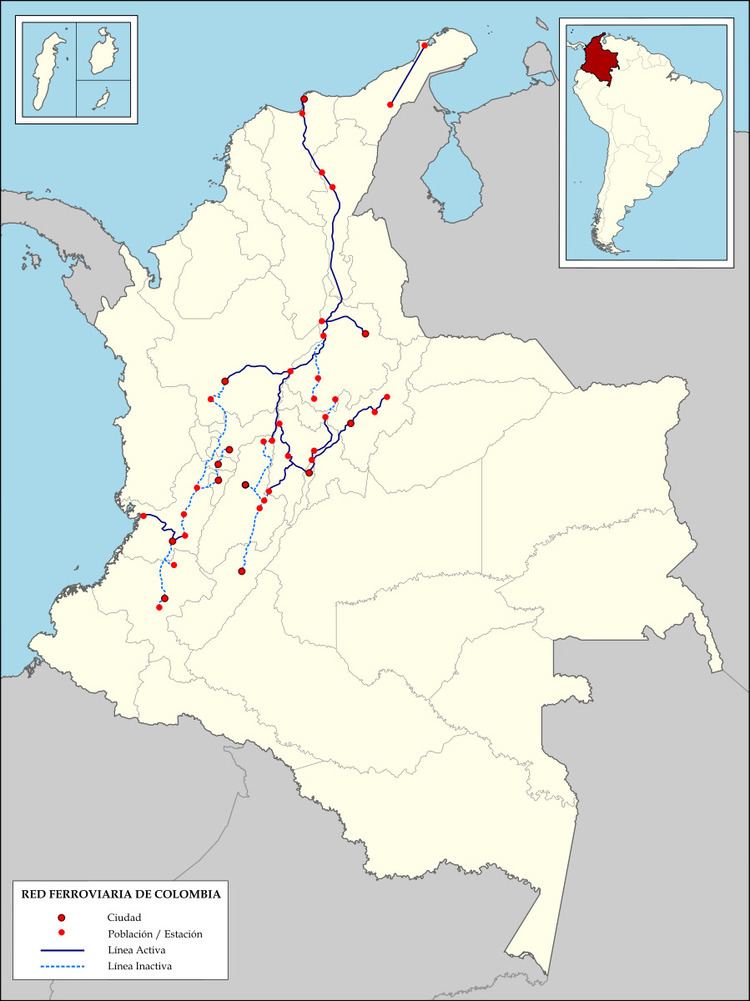 | ||
The Colombia railway network has a total length of 3,304 kilometres (2,053 mi). There are 150 kilometres (93 mi) of 1,435 mm (4 ft 8 1⁄2 in) standard gauge connecting Cerrejón coal mines to the maritime port of Puerto Bolivar at Bahia Portete, and 3,154 kilometres (1,960 mi) of 3 ft (914 mm) narrow gauge of which 2,611 kilometres (1,622 mi) are in use. The state-owned railway company (National Railways of Colombia) was liquidated in the 1990s. Since then the only passenger trains are tourist trains on the Bogotá savanna railway between Bogotá and Zipaquirá. In addition a funicular operates up the mountain of Monserrate in Bogotá.
Contents
Railway concessions
Railway concessions were awarded on July 27, 1999, to Ferrocarriles del Norte de Colombia S.A. (FENOCO), as the Atlantic concession, and on November 4, 1998, to the Sociedad Concesionaria de la Red Férrea del Pacífico SA, later named Tren de Occidente SA as the Pacific concession. Since 1991 the section La Loma – Puerto Drummond, with 192 kilometres (119 mi), transports coal. Also from July 2003, the section Bogotá - Belencito, with 257 kilometres (160 mi), is operating on the Atlantic concession transporting cement. In the Pacific concession the section between La Paila and Buenaventura has a total of 292 kilometres (181 mi).
In November 2009, the Colombian government set up a new team of consultants and specialists to oversee the estimated $440m Sistema Ferroviario Central railway concession. The project involves building a 1,050 kilometres (650 mi) railway from La Dorada to Chiriguaná, linking Colombia's central area to the Santa Marta port on the Atlantic coast. Part of the proposed project are the construction of the La Dorada stretch, renovating the stretches connecting the districts of La Dorada and Buenos Aires, Puerto Berrío, Envigado and La Dorada and Facatativá, and maintaining the Chiriguaná-Buenos Aires stretch. The tender was suspended due to concerns of corruption, but restarted in February 2011.
Investment programmes
There is a US$600 million investment programme planned for 2008 and studies for a US$350 million new line between Puerto Berrío and Saboya. Under this contract sections of the Atlantic network Neiva – Villavieja and 177 km Ibagué – La Dorada would be built. Other sections to be built include Sogamoso – Tunja and Puerto Berrío – Cisneros.
China is looking into constructing a 220 kilometres (140 mi) railway between the port cities Buenaventura and Cartagena, connecting Colombia's Pacific and Caribbean coasts. This railway alternative would compete with the Panama Canal. Besides linking two coasts, China aims to make the import of Colombian coal and the export of Chinese manufactured goods to the Americas easier with this railway. Colombia hopes China's growing economic presence in the region will further the ratification of the Free Trade Agreement with the United States, the country's biggest trading partner.
A £47m agreement between the Colombian Ministry of Transport and UK Deputy Prime Minister Nick Clegg on February 3, 2014 plans to allow for the rehabilitation of two narrow gauge railway lines (one, 750 kilometres (470 mi) line from La Dorada to Chiriguaná and a second, 300 kilometres (190 mi) line from Belencito to Bogotá). The construction will use local contractors and is expected to take 18 to 24 months. The lines will be for freight traffic and the government is funding the construction but plans to privatize the route upon completion.
Metro
Medellín is the only city thus far (2015) to have built a metro (rapid transit) system. Consultants were appointed in 2014 to develop a metro system in the capital city Bogotá. (see → Bogotá Metro)
